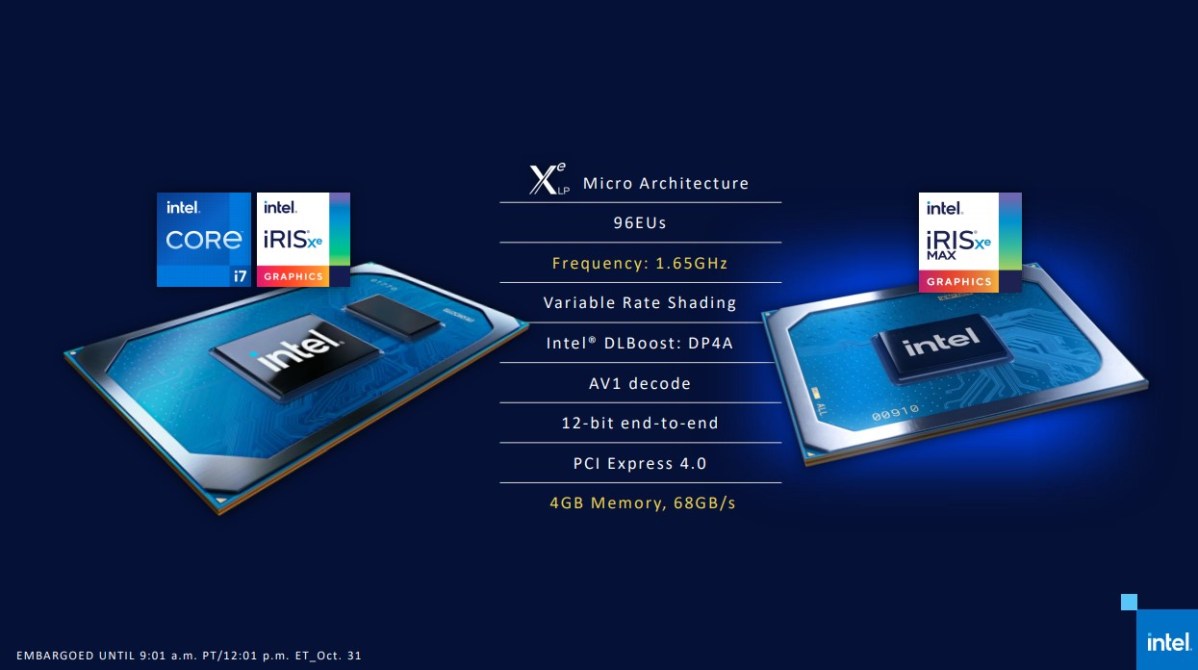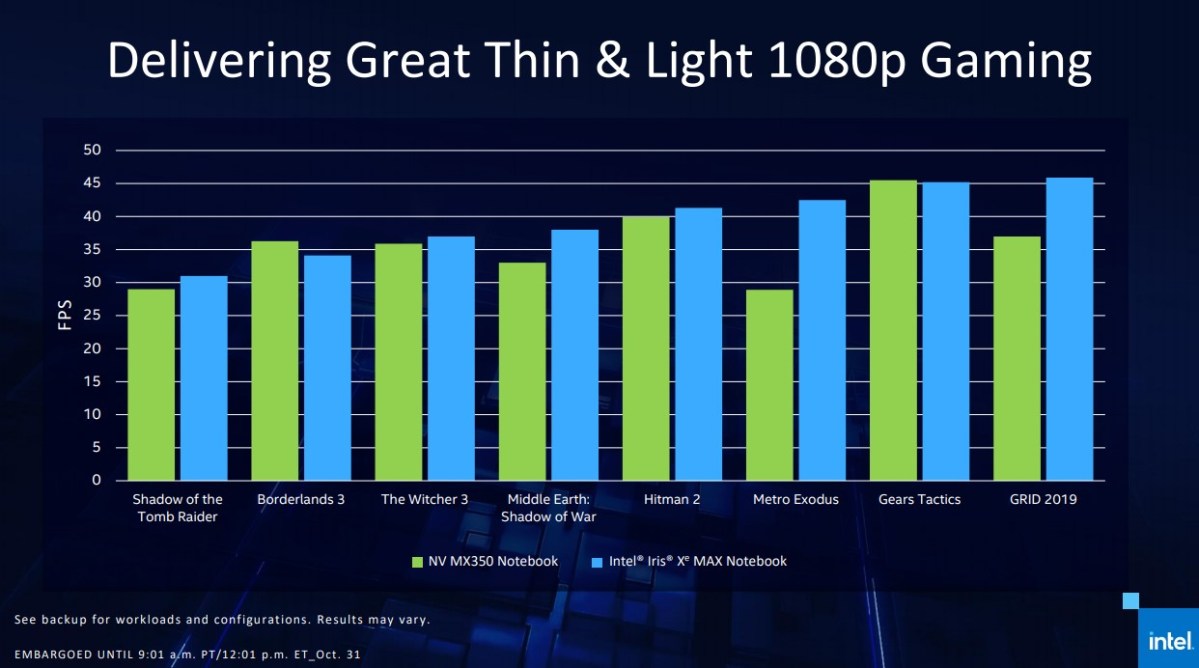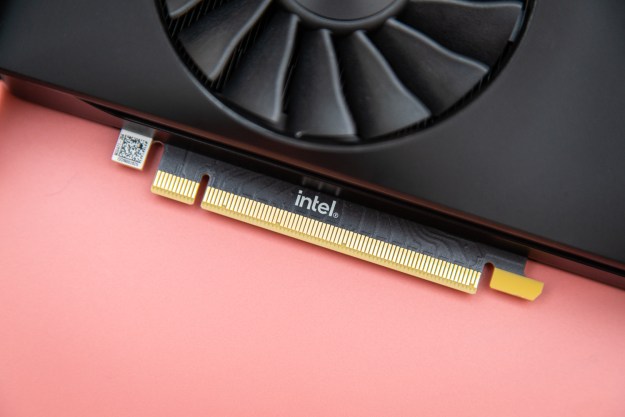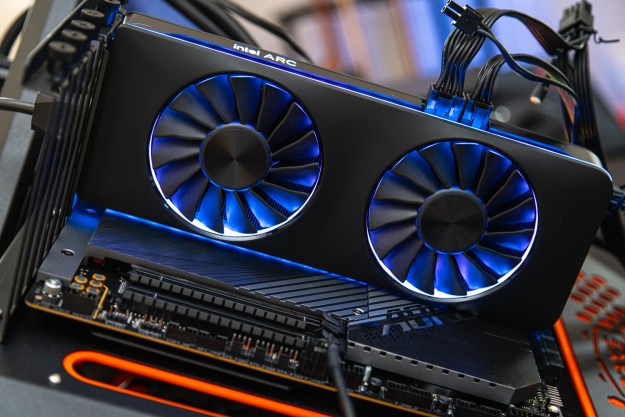Intel has launched its new Iris Xe Max graphics, now available in three laptops; Acer’s Swift 3x, Asus’ VivoBook Flip TP470, and Dell’s Inspiron 15 7000 2-in-1.
Following in the footsteps of Intel Iris Xe, which launched in Intel 11th-gen Core mobile processors earlier this year, Intel Xe Max is a discrete GPU built on the same Xe-LP architecture.

The key difference can be found in memory. Intel’s Iris Xe is an integrated graphics solution. That means it shares memory with the system’s overall RAM.
Intel Iris Iris Xe Max is discrete, which means it has dedicated memory. Specifically, it includes 4GB of memory with 68GB/s of memory bandwidth.
Intel Iris Xe Max also ups the quoted maximum frequency from 1.35GHz to 1.65GHz. Systems equipped with Iris Xe Max graphics will have a total of 192 EUs (96 from Iris Xe graphics on the Core mobile processor, and 96 from the Iris Xe Max chip).
Other important specifications include support for up to four simultaneous displays, resolutions up to 8K at 60Hz over DisplayPort, adaptive sync, and DirectX 12.1.
So, does the addition of discrete memory give Intel’s Iris Xe graphics outstanding game performance? That depends on your expectations.
Intel says Iris Xe Max provides “great thin-and-light 1080p gaming on popular games.” Specifically, that means between 30 frames per second (FPS) and 50 FPS in titles like Borderlands 3, The Witcher 3, and Gears Tactics. Intel expects this level of performance will put Iris Xe Max ahead of Nvidia’s MX350 discrete GPU.

On one hand, that’s not a high bar to clear. On the other, if Intel’s quotes are correct, Iris Xe Max will bring a notable boost in performance to the midrange, thin-and-light systems it’s designed for. Games like The Witcher 3 wouldn’t even launch on most thin-and-light laptops several years ago, as they often were forced to opt for an entry-level version of Intel integrated graphics. Iris Xe Max is a big step up from Intel UHD 620, or even Intel’s Iris Plus 640.
There is a quirk to note. According to Intel, some games might perform slightly worse on Intel Iris Xe Max graphics than on Intel Iris Xe. An Intel spokesperson said this is “typically due to latencies: Dual-rank versus single-rank, hybrid display copy, or traversing the PCIe bus.” The example given was DOTA 2, which was about 10 FPS slower on average with Iris Xe Max, though it did still exceed 70 FPS.
The takeaway is this. Intel is pitching a slight boost to game performance in midrange laptops. It’s not a revolution, but it is an improvement, and one that makes a wide variety of AAA games playable at 1080p, 30 FPS, and reasonable quality settings. And don’t forget the driver-level features, like Intel’s new Graphics Command Center, as well as support for high resolutions, adaptive sync, and multiple displays.
For creators, the plot thickens
While Intel promises better gaming performance from Iris Xe and Iris Xe Max, that’s only half the potential benefit. The company is pitching its new graphics architecture as an accelerator for numerous creative applications.
Intel is leaning on a technology it calls Deep Link, which “aggregates multiple processing engines through a common software framework,” to accelerate creative applications. Put simply, Intel hopes to make the many separate compute units on a modern Intel CPU and GPU combo work together closely, so that maximum performance is wrung out of a laptop’s power budget. The company also hopes the “common software framework” will help developers easily tap into Intel’s hardware, expanding software compatibility.

Iris Xe graphics includes media encoders and hardware elements that support DP4a, a mathematical operation often used by machine learning software. Intel says a laptop with Iris Xe Max graphics can deliver up to 1.78 times the encoding performance of Nvidia’s RTX 2080 GPU, and up to 7 times better “A.I.-based creation” than similar laptops with third-party (AMD or Nvidia) graphics.
I’d caution readers that “up to” is the operative phrase here. Intel’s is of course quoting the most optimal results, which aren’t reproducible in all scenarios. If you want to go into the weeds, Intel’s Performance Index provides detailed information about its performance claims.
To provide real-world evidence for Iris Xe Max, Intel offers a software bundle for anyone buying a qualifying device. Highlights in the pack include Gears Tactics and XSplit VCam, a tool for enhanced background blur and removal with any webcam. Intel also boats that Deep Link will deliver improvements with Handbrake and Open Broadcaster Software (OBS), among others.
More to come
Intel Xe Max is the second major step forward in Intel’s push to improve its graphics offerings, following in the footsteps of Intel Iris Xe. Intel is still working to bring Xe-LP based graphics to “value desktops” in the first half of 2021, with additional Xe-HP and Xe-HPG hardware coming later in 2021.
Editors' Recommendations
- Intel may fire the first shots in the next-gen GPU war
- I’m a laptop reviewer, and I can’t wait for the new Windows on ARM laptops
- With the arrival of Core Ultra, a new era for Intel has begun
- Why the most powerful laptops of 2024 might not use Intel’s latest chips
- Apple’s M3 Max appears to keep up with Intel’s top desktop CPU

